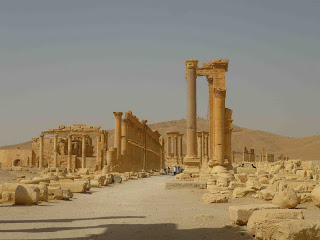
One of my recent day trips has been to Malula, a village north of Damascus where it is said St Paul first converted on his way to Antioch. Malula is now a Christian pilgrimage site. However several places make this claim in the mountains around Syria! Taking a small mini van (called a service) from Damascus it took an hour to reach the hills north of the city. A very striking landscape, with rolling hills interspersed with large rocky outcrops - it made for a dramatic journey. I was traveling with my housemates, a Norwegian, and a Syrian friend whose family come from Malula.
After jumping off the bus in the main roundabout of the town we found ourselves in the middle of a bowl of rocky outcrops, each decorated with crosses and Christian motifs. Very different from Damascus. After wandering through the narrow streets and through tunnels where houses were above, below and to the sides of us, we arrived at our friend's grandparents' house and had the first of many coffees. Interestingly Malula is one of the few places in Syria where people still speak Aramaic and my friend's grandma spoke only Aramaic. It was great to hear as it had a rhythm a bit like Irish! After having coffee and trying to remember our university Arabic we went on through the narrow streets and up to see a cousin of our guide. It seemed everyone knew him. Then after tasting Malula wine (sweet like communion wine) we wandered up to one of several religious buildings in Malula, a convent. The story goes that the saint of the convent, after converting to Christianity escaped her father to Malula. Her father sent soldiers after her and she managed to evade capture when God opened a rock so that she could hide. The place where this is said to have happened is now a shrine where people come for healing and prayer. It was a lovely little shrine with a tree and a cave - lovely to get out of the heat of the day. The sign outside in English read, "Please enjoy your visit but your smoking harms us."
We then wandered up a gorge and round the back of one of the outcrops of Malula which gave great views of the plateau around the town. It was here that some of The Lord of the Rings was filmed apparently. After looking at the view from a hotel that was being renovated we went to one of the oldest churches in Syria, dating from the 5th century. Inside it was small square space with four arches holding up the roof. Everything was very simple and plain, but sadly tour group after tour group ruined the atmosphere, a pattern in Syria! After taking this in we had more coffee with our friend's other grandparents, this time conversation in arabic and then headed back to Damascus in another mini van for yet more coffee.


